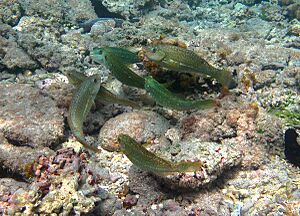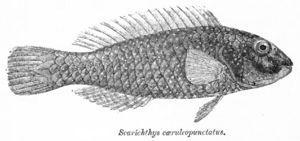Marbled parrotfish facts for kids
Quick facts for kids Marbled parrotfish |
|
|---|---|
 |
|
| Males with a whitish line along their side, females without | |
| Conservation status | |
| Scientific classification | |
| Synonyms | |
|
The marbled parrotfish (Leptoscarus vaigiensis), also known as the seagrass parrotfish, is a type of colorful fish that lives in the ocean. It's part of the parrotfish family and is the only known species in its group, called a genus.
You can find this fish in many warm waters around the world. It lives in the Indo-Pacific region and also in parts of the southeastern Atlantic Ocean. This fish likes to live near the coast in areas with lots of seagrass and seaweed.
Contents
What the Marbled Parrotfish Looks Like
The marbled parrotfish has a unique look. Its body can be brown or green, with darker spots on its back. These spots fade to yellow or greenish colors on its belly.
Male and female marbled parrotfish look a bit different. Males have a pale stripe running along their sides. Their head, back fin (dorsal fin), and belly fin (anal fin) are covered with small blue spots. Females have mottled brown and white patterns. They also have wide bands on their heads that spread out from their eyes.
This fish has special fins. It has 9 spines and 10 soft rays in its dorsal fin. The anal fin has 3 spines and 9 soft rays. Its side fins (pectoral fins) have 13 rays.
One of the most interesting features is its mouth. Its teeth are fused together, forming a beak-like shape, much like a parrot's beak. These dental plates are covered in many tiny teeth. When the fish closes its mouth, the upper jaw's teeth fit inside the lower jaw. The marbled parrotfish can grow up to about 35 centimeters (14 inches) long.
Where Marbled Parrotfish Live
The marbled parrotfish lives in a wide area, from the Red Sea in the north, all the way down the eastern coast of Africa to the Cape of Good Hope. It also lives across the Indian Ocean and Pacific Ocean, reaching as far as Easter Island.
In the Pacific, you can find them north of Japan and south near Rottnest Island in Western Australia and the Poor Knights Islands of New Zealand. They are also found in False Bay in South Africa, which is in the southeastern Atlantic. This fish is often found in both the Northern and Southern Hemispheres, but it's rare near the Equator.
Habitat and Life Cycle
Marbled parrotfish prefer to live in calm places like sheltered bays, harbors, and lagoons. They are often found among beds of seagrass and on reefs covered with algae. They usually swim in small groups.
These fish live in shallow waters, from the surface down to about 15 meters (50 feet) deep.
Reproduction
Unlike many other parrotfish, female marbled parrotfish never change into males. They stay female their whole lives. This is called being gonochoristic.
They lay their eggs in shallow water over flat seagrass beds. This usually happens when the tide is going out. Marbled parrotfish also show less difference in appearance between males and females compared to most other parrotfish species.
What They Eat
The marbled parrotfish mainly eats seagrass and algae. When they are very young, the baby fish (larvae) often float around with drifting algae.
Naming and History
The marbled parrotfish was first officially described in 1824. Two French naval surgeons and naturalists, Jean René Constant Quoy and Joseph Paul Gaimard, named it Scarus vaigiensis. They wrote about it in their book Voyage autour du monde. The place where they first found this fish was Waigeo.
Later, in 1839, a scientist named William Swainson created a new group, or genus, called Leptoscarus. The marbled parrotfish is the only species in this special group.
Marbled Parrotfish and People
People catch marbled parrotfish in local small-scale fisheries. They are usually sold fresh to eat.
In Queensland, Australia, there are rules for catching these fish. You can only catch a maximum of 5 marbled parrotfish as part of a total catch of 20 coral reef fish. Also, the fish must be at least 25 centimeters (10 inches) long.



